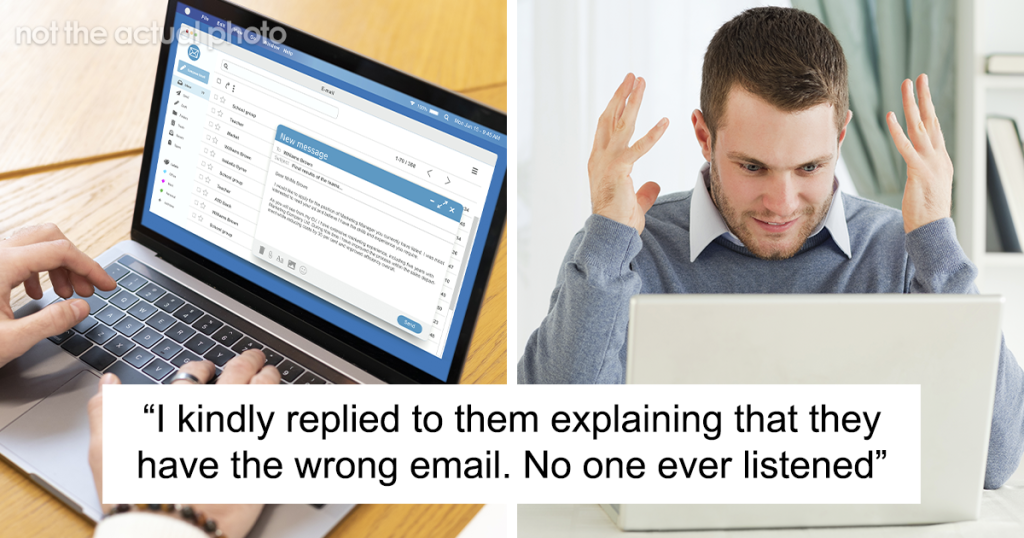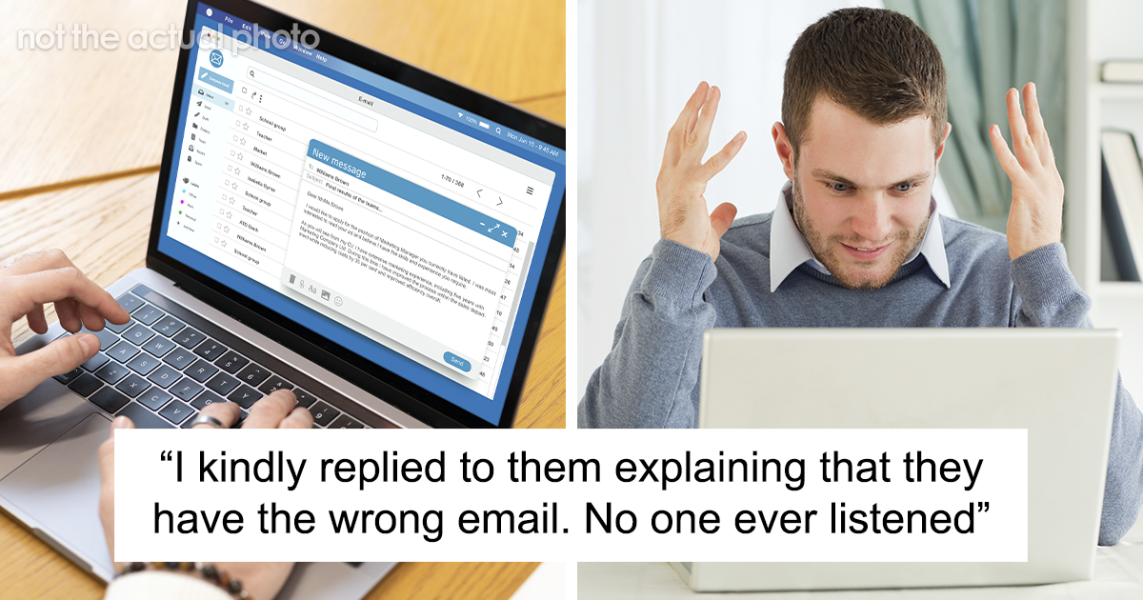“They Are All Idiots”: Mistaken Email Recipient Sparks Chaos In Corporate Chatroom – Bored Panda

No fees, cancel anytime Log InorSign UporReset your passwordEnter your email address or username and we’ll send you a link to reset your passwordCheck your inbox An email with a link to reset your password was sent to the email address associated with your account Provide emailPlease enter your email to complete registrationActivate to continueYour account isn’t active yet. We’ve emailed you an activation link. Please check your inbox and click the link to activate your accountThe Bored Panda iOS app is live! Fight boredom with iPhones and iPads here. Join 1.2 million Panda readers who get the best art, memes, and fun stories every week! P.S. It’s 100% free, unsubscribe anytime.You’re on the list! Expect to receive your first email very soon! 24 20Link copied!ShareLink copied!ShareSpam is, unfortunately, an unavoidable side effect of having an email address. At this point, most of us have probably already given up on trying to keep up with our inboxes overflowing with various promotions, newsletters, and money offerings from African princes and just ignore them. However, some persist and refuse to succumb to this modern issue, finding ingenious ways to put an end to it. Just like this person, who, after being spammed with random company emails, tried messing with them in return. Their actions definitely worked, as the emails stopped, and as a bonus, they got some giggles out of it too.Scroll down to find the full story and conversation with Rajvardhan Oak, cyber security author and online fraud and scam researcher, and regional chief security officer Winifred Ndukwe, who kindly agreed to tell us more about spam emails and how to avoid them.Share iconImage credits: Wavebreak Media / freepik (not the actual photo)Share iconImage credits: freepikShare iconImage credits: BiackPandaShare iconImage credits: Racool_studio / freepik (not the actual photo)Out of 347 billion daily emails sent, 160 billion are spam emails. This means that almost half of the letters that end up in our digital inboxes are unnecessary junk.But how do spammers know where to send these unsolicited messages? “A person’s email can become susceptible to spam through various means, such as public exposure (e.g., sharing it in online forums or on social media), or data breaches at websites or services they use (breached data is often sold on the dark web),” explains Rajvardhan Oak, cyber security author and online fraud and scam researcher.“Sometimes spammers will scrape public registries (such as those of public universities) to obtain addresses to spam,” he adds.The content of spam emails can range from advertisements and subscriptions to fake giveaways and job offers, which can pose a real threat. “Beyond being a nuisance that clutters inboxes, spam emails are often used as vehicles for phishing attacks, where malicious actors impersonate legitimate entities to steal sensitive information such as login credentials, banking details, or personal data,” says Oak.“For individuals, this can lead to identity theft, and for organizations, it can mean financial loss, data breaches, or even reputational damage,” warns regional chief security officer Winifred Ndukwe.Share iconImage credits: freepik (not the actual photo)To avoid spam emails and protect ourselves from potential scam attacks, Oak recommends using a reliable email provider with robust spam filters, like Gmail or Outlook. “Ensure these filters are configured to automatically detect and segregate spam emails into a separate folder,” he notes.He also advises refraining from sharing email addresses publicly on forums, websites, or social media. This helps to reduce your visibility to spammers and bots.“Use a secondary email address for sign-ups, newsletters, or online purchases to protect your primary inbox. Unsubscribe from unwanted newsletters or marketing emails through legitimate links provided, but never interact with unknown or suspicious emails, as this confirms your address is active,” he adds.Oak additionally suggests periodically reviewing spam sources, blocking them, and reporting them to the email provider. “This provides ground truth labels and helps them improve the machine learning models that are detecting spam.”For extra protection, Ndukwe recommends enabling multi-factor authentication (MFA) and using strong, unique passwords to secure your accounts. She also warns to not engage with any links in spam emails, as it can make us bigger threats to spam and phishing attacks.“What might look like a harmless email could be the first step in a sophisticated attack. What worked to protect you last year might need tweaking now, so it’s important to stay informed and cautious,” says Ndukwe.Share iconShare iconShare iconBy entering your email and clicking Subscribe, you’re agreeing to let us send you customized marketing messages about us and our advertising partners. You are also agreeing to our Privacy Policy. Thank you! You’ve successfully subscribed to newsletters!Anyone can write on Bored Panda. Start writing! Follow Bored Panda on Google News! Follow us on Flipboard.com/@boredpanda! 24 20 24 20Link copied!ShareLink copied!Share Writer, BoredPanda staff Hi, glad you swung by! My name is Austėja, and I’m a writer at Bored Panda. With a degree in English philology, I’m interested in all aspects of language. Being fresh out of university, my mission is to master the art of writing and add my unique touch to every personal story and uplifting article we publish. In my time here, I’ve covered some fun topics such as scrungy cats and pareidolia, as well as more serious ones about mental health and relationship hiccups. When I’m not on my laptop, you’ll probably find me devouring pastries, especially croissants, paired with a soothing cup of tea. Sunsets, the sea, and swimming are some of my favorite things. Writer, BoredPanda staff Hi, glad you swung by! My name is Austėja, and I’m a writer at Bored Panda. With a degree in English philology, I’m interested in all aspects of language. Being fresh out of university, my mission is to master the art of writing and add my unique touch to every personal story and uplifting article we publish. In my time here, I’ve covered some fun topics such as scrungy cats and pareidolia, as well as more serious ones about mental health and relationship hiccups. When I’m not on my laptop, you’ll probably find me devouring pastries, especially croissants, paired with a soothing cup of tea. Sunsets, the sea, and swimming are some of my favorite things. Author, BoredPanda staff I’m a visual editor here at Bored Panda and I enjoy a good laugh. My work ranges from serious topics related to toxic work environments and relationship difficulties to humorous articles about online shopping fails and introvert memes. When I’m not at my work desk, checking if every single pixel is in the right place, I usually spend my free time playing board games, taking pictures, and watching documentaries Author, BoredPanda staff I’m a visual editor here at Bored Panda and I enjoy a good laugh. My work ranges from serious topics related to toxic work environments and relationship difficulties to humorous articles about online shopping fails and introvert memes. When I’m not at my work desk, checking if every single pixel is in the right place, I usually spend my free time playing board games, taking pictures, and watching documentaries Technically, OP received misaddressed emails, not spam emails. Though, my favorite response in the comments was the one who had modified the meeting minutes to include an action item to have their email address removed from the distribution list.GMail does not recognise dots in a name. So johnsmith@gmail.com will often get mail for john.smith@gmail.com – annoying, but that’s Google!That would be a serious defect and not meet the RFC standards for email addresses and SMTP. I have a hard time believing this is true.I don’t think they recognize any punctuation marks. This can be useful for setting up filters to process/redirect incoming email. In my case, firstlast goes to a work folder, first.last goes to a personal folder, and first_last goes to an ecomm folder. It’s like three separate email accounts in one.You realise that you can use the + character to have as many different email addresses as you like. Any characters after the % are ignored. e.g. robert+bordedpanda@gmail.com is treated the same as robert+facebook@gmail.com. So add the name of whomever you are giving your email address to and you will know who has shared it.Some 25 years ago, we started receiving group mail from à white-water kayaking group. I contacted our provider, who answered that it was absolutely impossible for two people to have the same address, but obviously one of the group had the same adress as my husband. Then some friends of theirs had a fatal kayaking accident, which was described in great détail on the group mail ( think the movie “Deliverance”) and I wrote to all of them saying we were sorry for their friends, but we’d like to be left out of it. Guess the one who had the same address as my husband changed his email, and we never heard from them again.Technically, OP received misaddressed emails, not spam emails. Though, my favorite response in the comments was the one who had modified the meeting minutes to include an action item to have their email address removed from the distribution list.GMail does not recognise dots in a name. So johnsmith@gmail.com will often get mail for john.smith@gmail.com – annoying, but that’s Google!That would be a serious defect and not meet the RFC standards for email addresses and SMTP. I have a hard time believing this is true.I don’t think they recognize any punctuation marks. This can be useful for setting up filters to process/redirect incoming email. In my case, firstlast goes to a work folder, first.last goes to a personal folder, and first_last goes to an ecomm folder. It’s like three separate email accounts in one.You realise that you can use the + character to have as many different email addresses as you like. Any characters after the % are ignored. e.g. robert+bordedpanda@gmail.com is treated the same as robert+facebook@gmail.com. So add the name of whomever you are giving your email address to and you will know who has shared it.Some 25 years ago, we started receiving group mail from à white-water kayaking group. I contacted our provider, who answered that it was absolutely impossible for two people to have the same address, but obviously one of the group had the same adress as my husband. Then some friends of theirs had a fatal kayaking accident, which was described in great détail on the group mail ( think the movie “Deliverance”) and I wrote to all of them saying we were sorry for their friends, but we’d like to be left out of it. Guess the one who had the same address as my husband changed his email, and we never heard from them again.We’re also on Instagram and tumblr 0comments 21 points 0replies 21 points 8comments 30 points 11replies 19 points 0comments 15 points 1comment 22 points 4comments 21 points 0comments 14 points 14replies 17 points 11comments 32 points
Source: https://www.boredpanda.com/getting-involved-random-company-emails-joins-chat/




